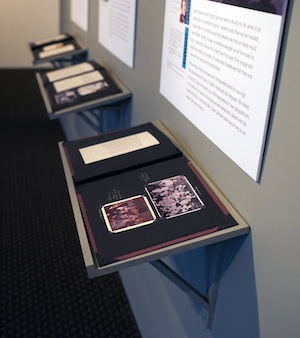The Open Hearts, Closed Doors exhibit combines placards of mixed visual and textual material. (photo from Vancouver Holocaust Education Centre)
“One out of every 122 people alive currently is displaced. That means 60 million people,” says Phillipa Friedland, education coordinator at the Vancouver Holocaust Education Centre.
Friedland is explaining the idea behind the current exhibit at the VHEC, Open Hearts, Closed Doors: The War Orphans Project, which was originally mounted in 1997. According to the centre’s website, it is “being re-presented to provide opportunities for visitors to engage with Canadian immigration policies from a historical perspective, using case studies of Holocaust survivors from the local community.”
The exhibit – which runs to June 30 – serves as a testament and warning about the vulnerability of children in times of communal violence. It is also a memorial to the incredible resilience of so many of survivors. The words of survivor Regina Feldman are written above one of the displays: “People were saying that we were free. I didn’t know what freedom meant. Where do you go, what do you do, who will take you? I was 13 years old.”

Open Hearts, Closed Doors reports the staggering statistic that of the 1.6 million Jewish children in Europe in 1938, only 100,000 survived. The exhibit combines general education about those who survived as orphans with a presentation of the experiences of nine war orphans – Esther Brandt, Marie Rozen Doduck, David Ehrlich, Regina Feldman, Bill Gluck, Celina Lieberman, Leo Lowy, Leslie Spiro and Robbie Waisman – who were among the 1,123 granted permission to enter Canada in 1947.
Permission for the orphans to come to Canada came through a special Order in Council, which bypassed Canada’s racist immigration policies of the time. These restrictive policies had been developed and enforced by then-director of Canada’s Immigration Branch Frederick Charles Blair. Canada had the worst record among destination countries for Jewish refugees: only 5,000 Jews were accepted as refugees between 1933 and 1939. Between 1945 and 1948, among the 65,000 refugees allowed into Canada, only 8,000 were Jews. Chaim Weizmann, Israel’s first president, remarked in 1938, “The world seemed divided into two parts: those places where the Jews could not live and those where they could not enter.”
The 1,123 orphans of 1947 were allowed into the country on the condition that Canadian Jews take full responsibility for them. Most of the orphans came through the port of Halifax at Pier 21 and boarded trains for 38 communities across the country. The majority of the orphans, more than 790 of them, settled in Montreal and Toronto; 38 settled in British Columbia, four of whom are still alive.
Most foster families were hoping for young children, preferably girls, but the majority of those who had managed to survive were older boys: 70% were adolescent boys and only 37 of the children were under 10 years of age. The orphans came from 15 different European countries, 783 from concentration camps and 229 who survived in hiding. The resettlement project was a massive undertaking practically and psychologically, for both the orphans and their new families. The success of that undertaking can be seen in the amazing lives that so many of the refugees lived.
“This entire exhibit is about resilience,” said Friedland. In the 1950s, psychiatrists who interviewed the surviving orphans offered a bleak prognosis: these were damaged people, their ability to adapt would be limited and they would likely not live long lives. Yet, as they aged, juvenile delinquency was practically nonexistent among them. Multilingual, they quickly picked up English. As the VHEC exhibit states, “Many became not only productive members of the community but its pillars.”
Open Hearts, Closed Doors combines placards of visual and textual material with beautifully done recreations of photo albums telling the stories of the nine survivors featured. A lone glass case contains a single child’s shoe taken from an innocent sent to the gas chambers.
True to its inspiration, the exhibit does not limit its focus to the past but looks to the present and future as well. A map on one wall of the exhibit shows regions throughout the world most at risk of genocide according to the Early Warning Project. These include Myanmar, Nigeria, Sudan and others.
Open Hearts, Closed Doors perfectly fulfils the mandate of a Holocaust exhibit: it remembers the horrors and heroism of the Shoah while pointing us towards the need to protect the vulnerable everywhere.
Matthew Gindin is a Vancouver freelance writer and journalist. He blogs on spirituality and social justice at seeking her voice (hashkata.com) and has been published in the Forward, Tikkun, Elephant Journal and elsewhere.

